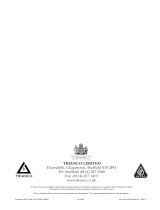
10 Euroflame Oil Boilers
The Euroflame range of automatic pressure jet oil
boilers have been designed for use with a central
heating system with indirect domestic hot water
cylinder. They are not suitable for use with either a
direct cylinder or a 'primatic' cylinder.
The boilers are also suitable for use on sealed central
heating systems.
There are five versions of the Euroflame available, the
50/70, 50/90 System, 70/90, 90/120 and 90/120
System. The 50/70, 70/90 and 90/120 can be supplied
as Kitchen/Utility or uncased Boiler House models.
The 50/70 can be adjusted to a maximum output of
20.5 kW (70 000 Btu/h), the 50/90 System 26.4 kW
(90 000 Btu/h), the 70/90 26.4 kW (90 000 Btu/h) and
the 90/120 35 kW (120 000 Btu/h).
The boilers are supplied as Conventional flue models,
if a Balanced flue version is ordered, a Balanced Flue
Kit is required. Kits available include:- Concentric Low
Level Balanced Flue, Square Low Level Balanced Flue
(Short, Standard, Long and Extra Long) and Concentric
High Level Balanced Flue, all suitable for left, right or
rear outlet and a Vertical Concentric Balanced Flue.
Kitchen/Utility models are supplied with the burner
factory fitted. The burners for Boiler House models
are supplied in a separate carton. A burner supply
cable is supplied pre-wired to all burners.
The 50/90 and 90/120 Kitchen/Utility System boilers
are sealed system versions of the standard Euroflame
Kitchen/Utility boilers. They are supplied factory
fitted with a complete sealed system kit incorporating
a 12 litre expansion vessel, automatic air vent,
pressure relief safety valve assembly, pressure gauge
and filling loop. A circulating pump and isolating
valves are also fitted. Both the pump and burner are
pre-wired for ease of installation.
All burners are pre-set for use with kerosene and
are supplied ready to connect to a single pipe
fuel supply system with a loose flexible fuel line
(900 mm) and 3/8" to 1/4" BSP male adaptor
supplied with the boiler. If required, an
additional flexible fuel line (900 mm) and 3/8" to
1/4" BSP male adaptor are available from Grant
Engineering (UK) Limited, for two-pipe oil
supply system.
All models are suitable for use with Class C2 kerosene
or Class D gas oil. See sections 2.2 and 2.3.
Note: Only Kerosene may be used with Low Level
Balanced flues.
If the fuel to be used is Gas Oil or the boiler output is
to be changed, it may be necessary to change the
burner nozzle, burner head and top baffle plate
position (50/90 only). Refer to the Technical
Information in sections 2.2 and 2.3.
To change the nozzle on a Kitchen/Utility model,
remove the burner from the boiler then remove the
burner head/nozzle as described in section 7.4. For a
Boiler House model, unpack the burner and remove
the burner head/nozzle as described in section 7.4. To
remove and adjust the 50/90 top baffle plate refer to
section 7.3. The installer must amend the boiler data
label accordingly.
The temperature of the water leaving the boiler to heat
the radiators and hot water cylinder is User adjustable
from 65 to 85°C on Kitchen/Utility models and 60 to
90°C on Boiler House models.
The boilers are fitted with an overheat thermostat
(allowing them to be used on sealed central heating
systems) which will automatically switch off the boiler
if the heat exchanger exceeds a pre-set temperature of
111°C ± 3°C.
The control panel fitted to the Kitchen/Utility and
System models has an On/Off switch (with neon
indicator light), boiler thermostat control knob and the
manual reset button for the overheat thermostat. The
System models also have a system pressure gauge.
Both Boiler House models are supplied with a
combined boiler and overheat thermostat with a boiler
thermostat control knob and the manual reset button
for the overheat thermostat.
Boiler description
3.1
3 - GENERAL BOILER INFORMATION
























